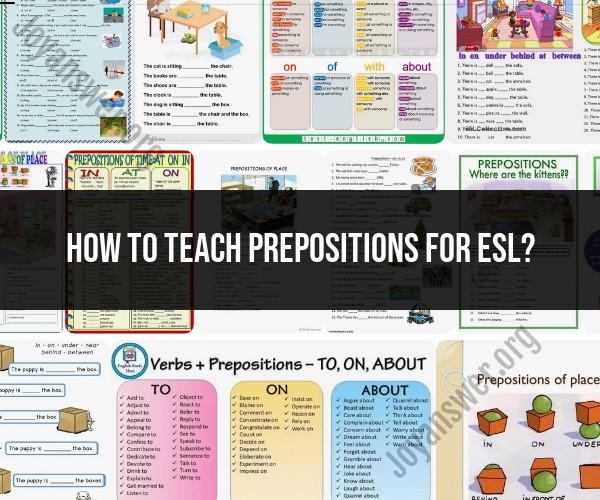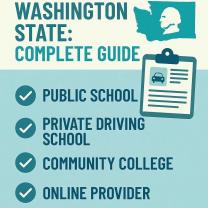How to teach prepositions for ESL?
Teaching prepositions to ESL (English as a Second Language) learners can be challenging, but it's essential for them to understand how prepositions work in English, as they play a crucial role in conveying relationships between objects, people, and locations. Here are some effective strategies for teaching prepositions to ESL learners:
Start with Basic Prepositions:Begin with common prepositions like "in," "on," "under," "beside," "between," "next to," and "behind." These are prepositions that learners are likely to encounter frequently.
Visual Aids:Use visual aids, pictures, or real objects to illustrate the meaning of prepositions. For example, show a picture of a ball on a table to demonstrate "on the table." Visuals can make it easier for learners to grasp the concept.
Real-Life Context:Teach prepositions in the context of everyday activities. Have learners describe the location of objects or people in the classroom or their own homes. For example, "The book is on the desk."
Physical Movement:Incorporate physical movement to reinforce prepositions. Ask students to move around the classroom and position themselves relative to objects or other students. For instance, "Stand next to the window" or "Sit behind your partner."
Preposition Games:Engage learners in games or activities that involve prepositions. Games like "Simon says" or "Hide and seek" can help reinforce prepositions while making learning fun.
Preposition Songs and Rhymes:Use songs, chants, or rhymes that include prepositions. This can be a memorable way for students to learn and remember prepositions.
Preposition Worksheets:Provide worksheets and exercises for practice. These can include fill-in-the-blank sentences or matching exercises.
Contrasting Prepositions:Teach prepositions that are often confused, such as "in" and "on" or "at" and "on." Highlight the differences in usage to avoid common mistakes.
Preposition Flashcards:Create preposition flashcards with images or sentences on one side and the prepositions on the other. Use these cards for review and quizzes.
Reading and Writing Exercises:Encourage ESL learners to read and write sentences or short paragraphs that include prepositions. This helps them practice using prepositions in context.
Feedback and Correction:Correct errors and provide feedback when learners make mistakes with prepositions. Encourage them to self-correct whenever possible.
Progressive Learning:Introduce prepositions progressively, starting with the basics and moving on to more complex ones. Build on their understanding as they become more proficient.
Cultural Context:Explain how prepositions might be used differently in English-speaking cultures compared to the learners' native language. This can help avoid misunderstandings.
Patience and Repetition:Be patient, as mastering prepositions can take time. Reinforce prepositions regularly in various contexts to ensure understanding and retention.
Remember that practice and repetition are key to mastering prepositions. Tailor your teaching methods to the age and proficiency level of your ESL learners and provide plenty of opportunities for them to use prepositions in meaningful ways.
Approaches to teaching prepositions to ESL (English as a Second Language) learners
Here are some approaches to teaching prepositions to ESL learners:
- Explicit instruction: This involves teaching prepositions directly, by explaining their meaning and usage. Explicit instruction can be done through formal lessons, games, activities, and real-world examples.
- Implicit instruction: This involves exposing learners to prepositions in context, without explicitly teaching their meaning or usage. Implicit instruction can be done through reading, listening, and speaking activities.
- Integrative instruction: This combines explicit and implicit instruction. It involves teaching prepositions directly, while also providing learners with opportunities to use them in context.
Practical examples and exercises for teaching prepositions in context
Here are some practical examples and exercises for teaching prepositions in context:
- Use pictures and real objects: Show learners pictures or real objects and ask them to identify the prepositions that are used. For example, you could show a picture of a ball on the table and ask learners to identify the preposition "on."
- Use gestures and actions: Use gestures and actions to help learners understand the meaning of prepositions. For example, you could point to the door and say "in" to show learners that the preposition "in" is used to talk about locations inside of something.
- Use songs, chants, and games: Songs, chants, and games can be a fun and engaging way to teach prepositions. For example, you could sing a song about the different prepositions of place, or play a game where learners have to race to identify the prepositions in a sentence.
- Use reading and listening activities: Have learners read and listen to texts that contain prepositions. Ask them to identify the prepositions and explain their meaning.
- Use speaking and writing activities: Have learners use prepositions in their speaking and writing. For example, you could have them write a story about a trip they took, using prepositions of place and movement.
The role of visual aids and real-life scenarios in preposition instruction
Visual aids and real-life scenarios can play an important role in preposition instruction. Visual aids, such as pictures, diagrams, and charts, can help learners to understand the meaning of prepositions and how to use them in context. Real-life scenarios can provide learners with opportunities to practice using prepositions in a meaningful way.
Here are some examples of how to use visual aids and real-life scenarios in preposition instruction:
- Use pictures to show the different prepositions of place: Show learners pictures of objects in different locations, such as a ball on the table, a book in the bag, and a cat under the chair. Ask learners to identify the prepositions that are used in each picture.
- Use diagrams to show the different prepositions of movement: Show learners diagrams of people or objects moving from one place to another, such as a person walking from home to school, or a ball rolling down a hill. Ask learners to identify the prepositions that are used in each diagram.
- Use real-life scenarios to practice using prepositions: Have learners give directions to a place, describe a picture, or tell a story, using prepositions.
Incorporating prepositions into speaking and writing exercises for ESL students
Here are some ways to incorporate prepositions into speaking and writing exercises for ESL students:
- Have learners describe pictures: Show learners pictures and have them describe what they see, using prepositions. For example, you could show a picture of a park and have learners describe the people and objects in the park, using prepositions such as "on," "in," "under," and "behind."
- Have learners give directions: Give learners a destination and have them give directions to that destination, using prepositions. For example, you could tell learners to give directions to the bathroom or the library.
- Have learners write stories: Have learners write stories about their experiences, using prepositions. For example, you could have learners write a story about their trip to the zoo or their day at school.
Assessment and tracking progress in preposition learning for ESL learners
Here are some ways to assess and track progress in preposition learning for ESL students:
- Observations: Observe learners during speaking and writing activities to see how they are using prepositions.
- Quizzes and tests: Give learners quizzes and tests to assess their knowledge of prepositions.
- Writing samples: Collect writing samples from learners and look for how they are using prepositions.
By tracking learners' progress over time, teachers can identify areas where learners may need additional support.
Here are some additional tips for teaching prepositions to













